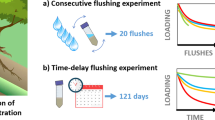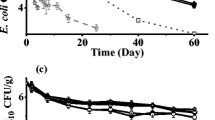Abstract
Escherichia coli O157:H7 gfp and Salmonella enterica Typhimurium gfp passed through six successive habitats within a microbial cycle. Pathogen cultures were introduced into cow dung or fodder. Microscopically observed cells and CFUs were monitored in fodder, dung, dung-soil mix, rhizosphere and phyllosphere of cress or oat plants grown in infested dung–soil mix, and in excrements of snails or mice fed with contaminated cress or oat shoots. Both methods were sensitive enough to monitor cells and CFUs throughout the chain. There was a positive correlation between cells and CFUs. Both pathogens declined through the successive habitats, but with unexpected increased densities on plants compared to dung–soil mix. Pathogen densities were higher in the phyllosphere than the rhizosphere of cress, but for oat plants this was reverse. Survival in dung was better after passage through the digestive tract of cows than after introduction of cultures into dung. Positive correlations between pathogens and copiotrophic bacteria (CB) and dissolved organic carbon (DOC) were observed in dung and dung-soil mixtures, but at low DOC contents CB densities were higher than pathogen densities. Thus, the pathogens are able to cycle through different habitats, surviving or growing better at high DOC concentrations, but maintaining population densities that are sufficiently high to cause disease in humans.





Similar content being viewed by others
References
Barker GM (2002) Gastropods as pests in New Zealand pastoral agriculture, with emphasis on Agriolimacidae, Arionidae and Milacidae. In: Barker GM (ed) Molluscs as crop pests. CAB International, London, pp 361–415
Beuchat LR (2002) Ecological factors influencing survival and growth of human pathogens on raw fruits and vegetables. Microbes Infect 4:413–423
Crump JA, Griffin PM, Angulo FJ (2002) Bacterial contamination of animal feed and its relationship to human foodborne illness. Clin Infect Dis 35:859–865
Davis MA, Cloud-Hansen KA, Carpenter J, Hovde CJ (2005) Escherichia coli O157:H7 in environments of culture-positive cattle. Appl Environ Microbiol 71:6816–6822
Dong Y, Iniguez AL, Ahmer BMM, Triplett EW (2003) Kinetics and strain specificity of rhizosphere and endophytic colonization by enteric bacteria on seedlings of Medicago sativa and Medicago truncatula. Appl Environ Microbiol 69:1783–1790
Fairbrother JM, Nadeau E (2006) Escherichia coli: on-farm contamination of animals. Rev Sci Tech Off Int Epizoot 25:555–569
Franz E, Klerks MM, de Vos OJ, van Diepeningen AD, Termorshuizen AJ, van Bruggen AHC (2007) Farm prevalence of STEC stx1, stx2, eaeA and rfbE genes and survival of E. coli O157:H7 in manure from organic and low-input conventional dairy farms. Appl Environ Microbiol 73:2180–2190
Franz E, Semenov AV, Termorshuizen AJ, Bokhorst JG, van Bruggen AHC (2008) Manure-amended soil characteristics affecting the survival of E. coli O157:H7 in 36 Dutch soils. Environ Microbiol 10:313–327
Franz E, Semenov AV, van Bruggen AHC (2008) Modelling the contamination of lettuce with Escherichia coli O157:H7 from manure-amended soil and the effect of intervention strategies. J Appl Microbiol 105:1569–1584
Franz E, van Bruggen AHC (2008) Ecology of E. coli O157:H7 and Salmonella enterica in the primary vegetable production chain. Crit Rev Microbiol 34:143–161
Franz E, van Diepeningen AD, de Vos OJ, van Bruggen AHC (2005) Effects of cattle feeding regimen and soil management type on the fate of Escherichia coli O157:H7 and Salmonella enterica serovar Typhimurium in manure, manure-amended soil, and lettuce. Appl Environ Microbiol 71:6165–6174
Franz E, Visser AA, Van Diepeningen AD, Klerks MM, Termorshuizen AJ, van Bruggen AHC (2007) Quantification of contamination of lettuce by GFP-expressing Escherichia coli O157:H7 and Salmonella enterica serovar Typhimurium. Food Microbiol 24:106–112
Fratamico PM, Deng MY, Strobaugh TP, Palumbo SA (1997) Construction and characterization of Escherichia coli O157:H7 strains expressing firefly luciferase and green fluorescent protein and their use in survival studies. J Food Prot 60:1167–1173
Guber AK, Karns JS, Pachepsky YA, Sadeghi AM, van Kessel JS, Dao TH (2007) Comparison of release and transport of manure-borne Escherichia coli and enterococci under grass buffer conditions. Lett Appl Microbiol 44:161–167
Himathongkham S, Bahari S, Riemann H, Cliver D (1999) Survival of Escherichia coli O157:H7 and Salmonella typhimurium in cow manure and cow manure slurry. FEMS Microbiol Lett 178:251–257
Hovde CJ, Austin PR, Cloud KA, Williams CJ, Hunt CW (1999) Effect of cattle diet on Escherichia coli O157:H7 acid resitance. Appl Environ Microbiol 65:3233–3235
Jensen AN, Dalsgaard A, Stockmarr A, Nielsen EM, Baggesen DL (2006) Survival and transmission of Salmonella enterica serovar Typhimurium in an outdoor organic pig environment. Appl Environ Microbiol 72:1833–1842
Jiang X, Morgan J, Doyle MP (2002) Fate of Escherichia coli O157:H7 in manure-amended soil. Appl Environ Microbiol 68:2605–2609
Klein DA, Casida LE Jr (1967) Escherichia coli die-out from normal soil as related to nutrient availability and the indigenous microflora. Can J Microbiol 13:1461–1470
Klerks MM, Franz E, van Gent-Pelzer M, Zijlstra C, van Bruggen AHC (2007) Differential interaction of Salmonella enterica serovars with lettuce cultivars and plant-microbe factors influencing the colonization efficiency. ISME J 1:620–631
Klerks MM, van Gent-Pelzer M, Franz E, Zijlstra C, van Bruggen AHC (2007) Physiological and molecular response of Lactuca sativa to colonization by Salmonella enterica serovar Dublin. Appl Environ Microbiol 73:4905–4914
Koupriyanov AA, Semenov AM, Van Bruggen AHC, Netrusov AI, Semenova EV (2009) Dynamics of the survival of enteropathogenic and saprotrophic bacteria passing through a birds' digestive tract in their excrement and in water. Moscow Univ Biol Sci Bull 64:102–106
Kudva IT, Blanch K, Hovde CJ (1998) Analysis of Escherichia coli O157:H7 survival in ovine or bovine manure and manure slurry. Appl Environ Microbiol 64:3166–3174
Kutter S, Hartmann A, Schmid M (2006) Colonization of barley (Hordeum vulgare) with Salmonella enterica and Listeria spp. FEMS Microbiol Ecol 56:262–271
Maciorowski KG, Herrera P, Jones FT, Pillai SD, Ricke SC (2007) Effects on poultry and livestock of feed contamination with bacteria and fungi. Anim Feed Sci Technol 133:109–136
Park S, Worobo RW, Durst RA (2001) Escherichia coli O157:H7 as an emerging foodborne pathogen: a literature review. Crit Rev Biotechnol 21:27–48
Römling U, Rohde M, Olsen A, Normark S, Reinköster J (2000) AgfD, the checkpoint of multicellular and aggregative behaviour in Salmonella typhimurium regulates at least two independent pathways. Mol Microbiol 36:10–23
Scott L, McGee P, Sheridan JJ, Earley B, Leonard N (2006) A comparison of the survival in feces and water of Escherichia coli O157:H7 grown under laboratory conditions or obtained from cattle feces. J Food Prot 69:6–11
Semenov AM, van Bruggen AHC, Kunenkova NN, Franz E, Semenova EV, Mikhailovich VM, Sobolev AY, Lapa SA, Solodovnikov YP, Sayler RJ, Römling U, Netrusov AI (2004) Experiments for risk analysis of the spread of enteropathogens in the environment within the microbial cycle. Proc 2nd Int Conf “Biotechnology to Environment” Sport and Culture Publ. part II, Moscow State Univ, Moscow, Russia, pp 163–168
Semenov AV, Franz E, van Overbeek L, Termorshuizen AJ, van Bruggen AHC (2008) Estimating the stability of E. coli O157:H7 survival in manure amended soils with different management histories. Environ Microbiol 10:1450–1459
Semenov AV, van Overbeek L, van Bruggen AHC (2009) Percolation and survival of E. coli O157:H7 and Salmonella enterica serovar Typhimurium in soil amended with contaminated dairy manure or slurry. Appl Environ Microbiol 75:3206–3215
Serrano S, Medina LM, Jurado M, Jodral M (2004) Microbiological quality of terrestrial gastropods prepared for human consumption. J Food Prot 67:1779–1781
Shere JA, Bartlett KJ, Kaspar CW (1998) Longitudinal study of Escherichia coli O157:H7 dissemination on four dairy farms in Wisconsin. Appl Environ Microbiol 64:1390–1399
Sivapalasingam S, Friedman CR, Cohen L, Tauxe RV (2004) Fresh produce: a growing cause of outbreaks of foodborne illness in the United States, 1973 through 1997. J Food Prot 67:2342–2353
Solomon EB, Yaron S, Matthews KR (2002) Transmission of Escherichia coli O157:H7 from contaminated manure and irrigation water to lettuce plant tissue and its subsequent internalization. Appl Environ Microbiol 68:397–400
Temelli S, Dokuzlu C, Cem Sen MK (2006) Determination of microbiological contamination sources during frozen snail meat processing stages. Food Control 17:22–29
Tyler HL, Triplett EW (2008) Plant as a habitat for beneficial and/or human pathogenic bacteria. Annu Rev Phytopathol 46:53–73
van Bruggen AHC, Franz E, Semenov AM (2008) Human pathogens in organic and conventional foods and effects of the environment. In: Givens I, Baxter S, Minihane AM, Shaw E (eds) Health benefits of organic food: effects of the environment. CAB International, Wallingford, pp 160–189
Van Elsas JD, Hill P, Chronakova A, Grekova M, TopalovaY ED, Kristufek V (2007) Survival of genetically marked Escherichia coli O157:h7 in soil as affected by soil microbial community shifts. ISME J 1:204–214
Vialette M, Jandos-Rudnik AM, Guyard C, Legeay O, Pinon A, Lange M (2004) Validating the use of green fluorescent-marked Escherichia coli O157:H7 for assessing the organism behaviour in foods. J Appl Microbiol 96:1097–1104
Vidovic S, Block HC, Korber DR (2007) Effect of soil composition, temperature, indigenous microflora, and environmental conditions on the survival of Escherichia coli O157:H7. Can J Microbiol 53:822–829
Williams AP, Roberts P, Avery LM, Killham K, Jones DL (2006) Earthworms as vectors of Escherichia coli O157:H7 in soil and vermicomposts. FEMS Microbiol Ecol 58:54–64
Winfield MD, Groisman EA (2003) Role of nonhost environments in the lifestyles of Salmonella and Escherichia coli. Appl Envrion Microbiol 69:3687–3694
Woolhouse MEJ, Taylor LH, Haydon DT (2001) Population biology of multihost pathogens. Science 292:1109–1112
Acknowledgements
We thank N.N. Kunenkova for preliminary laboratory work and E.V. Semenova for co-supervising N.N. Kunenkova and A.A. Kuprianov. This research and associated travel costs were funded by NWO-Russia collaborative grant #047.014.001 to A.H.C. van Bruggen and A.M. Semenov, a NATO-Russia Collaborative Linkage Grant, the EU CoreOrganic project ‘PATHORGANIC’ and by NWO fellowship #040.11.057 to A.M. Semenov. We are also thankful to the Erasmus Mundus External Cooperation project IAMONET-Russia for a cooperative grant to A.H.C. van Bruggen in 2008 and to A.M. Semenov in 2010.
Author information
Authors and Affiliations
Corresponding author
Rights and permissions
About this article
Cite this article
Semenov, A.M., Kuprianov, A.A. & van Bruggen, A.H.C. Transfer of Enteric Pathogens to Successive Habitats as Part of Microbial Cycles. Microb Ecol 60, 239–249 (2010). https://doi.org/10.1007/s00248-010-9663-0
Received:
Accepted:
Published:
Issue Date:
DOI: https://doi.org/10.1007/s00248-010-9663-0




